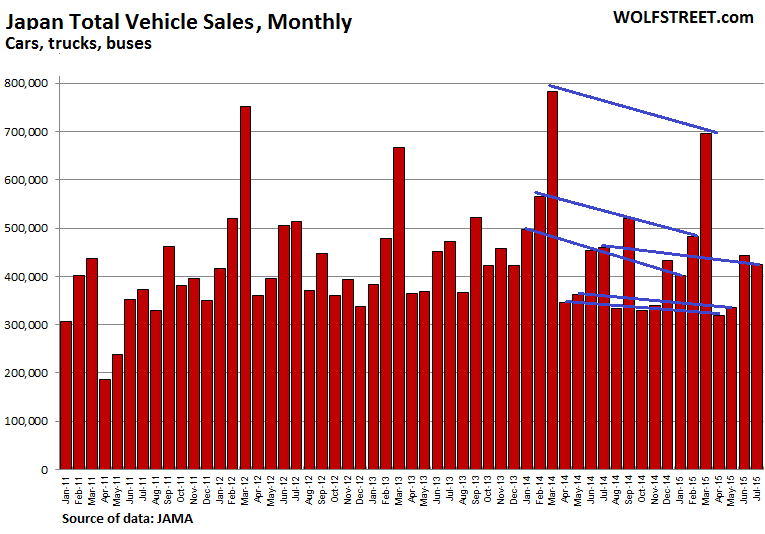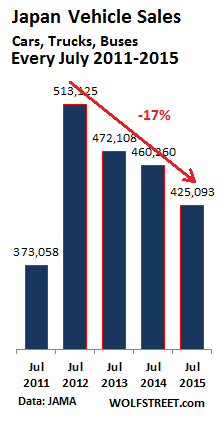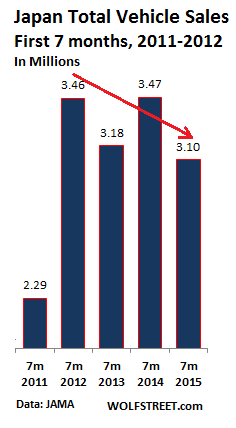Japanese consumers have borne the brunt of Abenomics even as the government has coddled Japan Inc., and as the Bank of Japan’s no-holds-barred money-printing campaign has pumped up the stock market.
They’ve had to digest a jump in the consumption tax, declining real incomes, and a devalued yen that makes import purchases, such as gasoline and a million other things, more expensive and that moves trips to foreign countries, long a cherished activity for the inhabitants of the island nation, out of reach.
It has shown up in the Consumer Confidence Index, released today by the Cabinet Office. The survey, covering households of two or more persons, paints a dreary picture. In July, the index fell 1.4 points to 40.3, the lowest level in six months. All sub-indices were down: “overall livelihood” fell to 38.1; “income growth” – a sad joke in Japan – fell to 39.6; “employment” fell to 44.7; and “willingness to buy durable goods,” such as cars, fell to 38.8.
Japanese households haven’t been exactly an enthusiastic lot. In the years between 2004 and 2007, the Consumer Confidence Index ranged from 45 to 50. But in early 2007, it began diving. By the time their general malaise had pushed the index down into the mid-30 range, the Financial Crisis blew up, pushing the index down even further. It bottomed out at 27. Consumer confidence then regained some feeble momentum to vacillate between 40 and 43, only to be felled by the horrific earthquake and tsunami of March 2011.
In late 2012, Shinzo Abe rode along on hope, promise, and a huge free lunch: unlimited printed money that would solve all of Japan’s problems. The honeymoon lasted over a year, until May 2013. That’s about when Japanese consumers came in contact with the conflux of rising prices and stagnating or falling incomes mixed with the anticipation of a broad consumption tax increase, effective April 1, 2014. It did its magic and hammered down consumer confidence. Things have been crummy ever since.
And it has mauled auto sales.
The Big Three Japanese automakers, which are global companies, are able to cover the malaise at home through an Abenomics miracle, the debauched yen. It allows them to translate the results from overseas operations and the value of exports into much weaker yen. If they had to report in dollars, they’d look pretty sad. But the market loves it that the debauchery of the yen sprays some superficial gloss on their income statements.
The debauched yen is of no help in their home market, however. And total vehicle sales – cars, trucks, and buses – have been cascading down relentlessly.
In July, 425,093 total vehicles were registered, according to the Japanese Automobile Manufacturers Association (JAMA), down 7.6% from July last year.
Auto sales are very seasonal in Japan. They surge toward the end of the fiscal year (March 31), with March being the peak month of the year. In April, sales collapse from March, and then revert back toward the mean. Various government incentives tend to skew sales results as well.
The consumption tax hike brought with it some special effects: consumers front-loaded on big-ticket items, including cars; hence the surge in car sales in the three months through March 2014. But it didn’t last long.
In this chart of monthly sales from 2011 through July 2015, note the slope of the blue lines that provide a year-over-year comparison of the more prominent months, starting with January 2014 (click on chart to enlarge):
The chart below shows total vehicle sales for the month of July of every year, going back to 2011, the earthquake year when commerce in Japan essentially came to a halt for months. Note how sales have dropped 17% from July 2012 to July 2015. Abenomics became Japan’s economic religion in late 2012:
For the first seven months this year, 3.102 million new cars, trucks, and buses were sold in Japan. That’s down 10.6% from the same period in 2014, which included the phenomenal pre-consumption-tax-increase front-loading party in January, February, and March, the month when it culminated with 783,384 vehicle sales. Alas, in March 2015, only 695,412 vehicles were sold, down 11.2%.
This chart shows total vehicle sales for the first seven months of the year, going back to 2011:
Turns out, in terms of total vehicles sales, the first seven months this year have been the worst January-July period since earthquake year 2011.
This is a great embarrassment for the economic religion of Abenomics. And a religion it is, requiring a huge leap of faith that enough miracles will intercede to make it all work out somehow. But miracles are rare these days. Instead, there is a bitter reality: Japanese consumers are being strung out, while the enormous benefits being heaped on Japan Inc. are not trickling down past the top layer and the hedge funds that invest in it.
In a toxic combination for Asia: as Japan is struggling, China is skidding. “We could see relatively strong downward pressure,” the Chinese government admitted. Read… China’s Hard Landing Suddenly Gets a Lot Rougher
Enjoy reading WOLF STREET and want to support it? You can donate. I appreciate it immensely. Click on the mug to find out how:
![]()





The Chinese has just devalued the Yuan. It’s just 1.9%, but is this the beginning of a currency war?
There has always been a large supply of second hand vehicles exported from Japan which are top condition and low mileage. I understood that the reason was a stringent safety check which was very expensive at 3 years old. Far cheaper to trade in for new. These used cars were a mainstay in nz until russians imported them and Fukushima issues.
I can imagine it will be an added problem for japanese who are suffering financially and can’t afford to trade up or to pay this 3 year safety check. One outcome may be a reduction in the number of cars per family – reflected in domestic new car sales.
As you can well imagine the dreaded safety inspection was put into place to allow politically connected carmakers (which in those days meant Toyota and Nissan) to have an effectively captive market: for example as a car was approaching its “expiration” date, Toyota dealerships (mostly owned by the manufacturer itself) usually approached their customers and offered them brand new cars at very favorable conditions. The system was so well oiled one didn’t even have to go to the dealership. If a potential customer expressed interest in a given model, a Toyota salesman would arrange to come around with that exact model (evenings, Saturdays and Sundays included), take the customer for a long test drive and then discuss the financial details over lunch or dinner, all paid for by Toyota. In a way it was what Mobutu Sese Seko said: “Steal a little and in a nice way”.
One of Japan’s greatest “mysteries” is one of those two politically connected carmakers, Nissan.
Nissan was spun off from the “New Zaibatsu” of that name when the Allies broke it up in 1946, prohibiting constituent companies to reform their previous ties. The term “New Zaibatsu” refers to Japanese industrial conglomerates formed after WWI, most of which had strong ties with the Imperial military, as opposed to the “Old Zaibatsu” (Mitsubishi, Sumitomo and Mitsui being the most prominent), which were formed during the Meiji Era at the end of the XIX century.
In spite of booming domestic sales, Nissan never, ever had a solid financial position. More often than not it bled red ink all over the place and even when it started shipping large numbers of cars and trucks abroad it remained in poor financial shape.
After the Bubble Economy popped, Nissan’s main banks (Fuji and the IBJ) started having more and more problems keeping the ailing manufacturer afloat, not to mention staying alive themselves. The Asian Crisis of 1997 was the death knell. The Japanese government would have liked to negotiate a merger with a domestic manufacturer, but Toyota wouldn’t touch Nissan with boxing gloves, Honda had even less reasons to be sympathetic and Mitsubishi was already negotiating a strategic alliance with Daimler. All was left was unloading Nissan upon French carmaker Renault in what the Japanese financial press called “the marriage of the weak”, and for good reasons.
The first inspection is at 3 years and then every two years:
http://www.navi.go.jp/inspection/category.html
The first inspection really isn’t that costly, but the cost increases as the car ages. The inspection system is really a joke and IMO a way of keeping people employed.
The used car market in Japan has changed quite a bit over the past 20 years or so.
When I left Japan I had to pay to get rid of my car, a Nissan Laurel. I couldn’t even give it away free. In comaprison when I moved to Australia that same car would have cost you around A$20,000………..
Several years ago I know a person that bought a used car in Japan, drove it for three years, and sold it for MORE than when they bought it.
People are keeping their used cars longer and paying the necessary shaken costs. They don’t have the money needed to buy a new car as often as in the past.
Furthermore, as the populations ages and people die, there is a decline in the demand for new cars as well.
There is also a large market for used Japanese vehicles in East Africa. However, these tend to be vehicles with 150K-200K+ km. Toyota, especially, has a good reputation for reliability. The fact that East Africa drives on the left makes Japan’s used cars suited for that market, unlike most cars made in the US or Germany.
I’ve tried twice in the past to negotiate at a Nissan dealership for a car of theirs that piqued my interest, the last in 2012. I really liked the design of the Cube, and test drove one. I got the idiot’s treatment both times and an attitude of “what do you think this is, a car dealership?” I went back to the Kia dealer and bought a Soul. Very happy with them, they still actually hire SALESMEN. And the car is great.